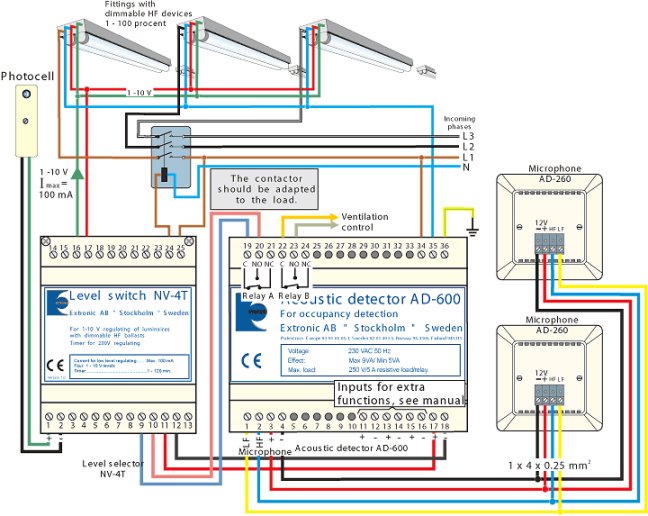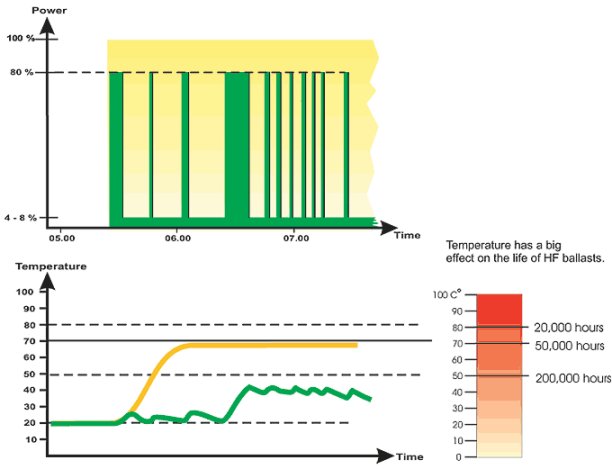1F. Closed garage with acoustic detector
Dimmable HF operating devices, with daylight-related ‘Dynamic Lighting control’ and four levels
Svenskt patent nr. 9201493-5, English patent No. 0659329
| Premises
For a closed single-level garage, acoustic technology is unsurpassed it is the only technology that permits activation before entry into the premises. For multi-storey open garages we refer to detection using IR detectors. Light sources The fittings in this garage have dimmable HF operating devices with analogue control (1 – 10 V). Control system With new buildings or renovations where there is the possibility of selecting fittings with dimmable operating devices, installation must be in accordance with the principle ‘Daylight-Related Dynamic Lighting Control’. The technology can be used for control using both acoustic and IR detectors. See wiring diagram below. Using NV-4T, dimmable fluorescent-tube fittings can control up to four light levels. The most important advantages attained using Dynamic Control are as follows:
|
Thanks to a light sensor, the lighting switches between a ‘day program’ and a ‘night program’ in NV-4T. In the daytime the light level is adjusted to about 80 per cent, and after onset of darkness the level is about 30 per cent in the event of presence. This means your eyes can more easily adjust to the light when entering and leaving the garage. The energy saving is furthermore about 20 per cent during daytime operation and about 70 per cent in the evening and night-time with the lighting activated. When the presence ceases (daytime and night-time) the lighting is first reduced to about 2 per cent of basic light, and after about 1 – 2 hours it is completely deactivated to eliminate no-load losses. See the diagram below! See application 1D with two lighting levels, without daylight-dependent control. Positioning of detectors The microphones should be positioned at up to twice the radius between them. The range of the microphones can be 20 – 25 m radius depending on acoustic conditions. Ceilings provided with acoustic plates can reduce the range of the HF signal. Connection of the microphones, which are connected in parallel, can use EKKX 1 x 4 x 0.25 mm2.
|
||||||||||||||||||||||
 |
|||||||||||||||||||||||
| Lighting control according to the light source manufacturer’s recommendations | |||||||||||||||||||||||
  |
|||||||||||||||||||||||
| Effect of temperature on the life of HF ballasts.
Running light sources at just 80 per cent and running ballasts at 80 per cent (including losses) gives a squared reduction in the heat generated in the light fittings. It also allows the installation to be run more intermittently, i.e. the lighting can be switched on for many short periods, which again reduces the temperature of the light fittings. This results in a lower steady state temperature, which significantly increases the life of HF ballasts. |
|||||||||||||||||||||||
 |
|||||||||||||||||||||||





